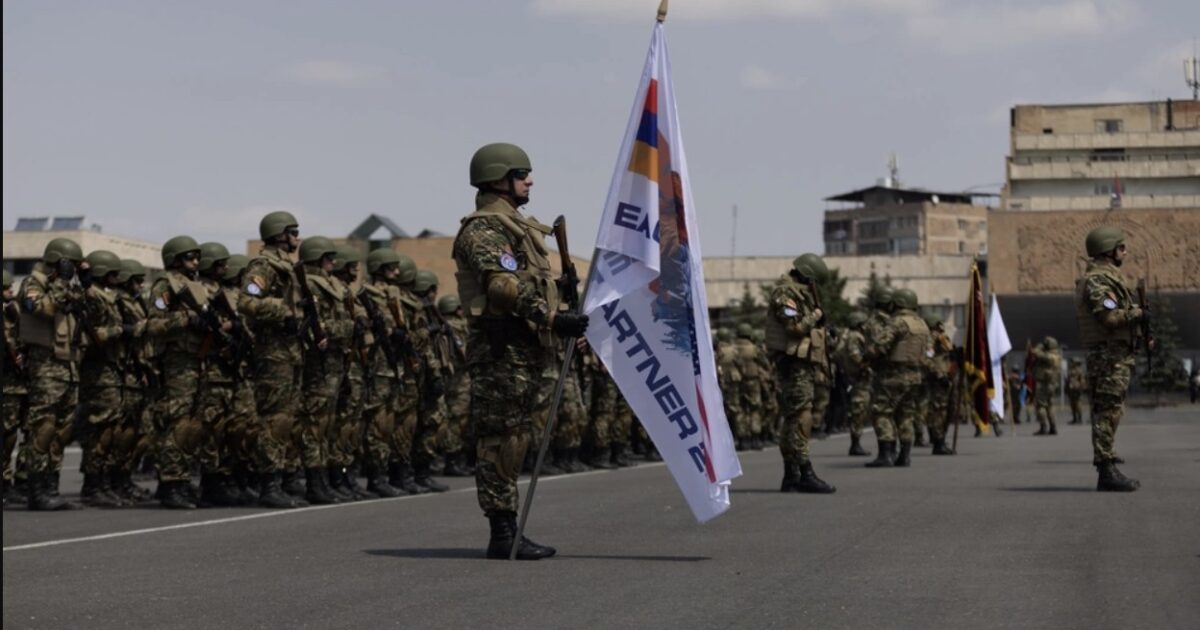The 2024 Eagle Partner joint military exercises brought together the Armenian Armed Forces and NATO forces, strengthening ties between the United States and Armenia. (U.S. Army photo by Spc. Alexcia Rupert)
On August 8, 2025, President Donald Trump presided over a historic peace agreement between Armenia and Azerbaijan, marking the end of a 35-year conflict and securing significant strategic and economic benefits for the United States. The signing took place at the White House with Armenian Prime Minister Nikol Pashinyan and Azerbaijani President Ilham Aliyev in attendance.
The agreement establishes a permanent ceasefire, mutual recognition of each other’s territorial integrity, and the normalization of diplomatic relations. At its core is the “Trump Route for International Peace and Prosperity” (TRIPP), a strategic transit corridor connecting Azerbaijan with its Nakhchivan exclave through Armenian territory. The United States holds exclusive development rights to this corridor, potentially for decades.
The deal also broadens U.S. cooperation with both countries in energy, trade, technology, and defense. It formally dissolves the long-ineffective OSCE Minsk Group, reducing Russian and European influence in the South Caucasus.
U.S. officials estimate the new transit corridor will generate billions of dollars in additional annual trade for Americans, with nine potential U.S. operators already expressing interest and formal negotiations now underway. The agreement grants American companies exclusive development rights, opening the door to major infrastructure projects including rail lines, oil and gas pipelines, and fiber optic networks, ultimately creating a fully integrated connectivity system under U.S. control.
The corridor will also facilitate the flow of energy from the resource-rich Caucasus to Western markets, a development senior officials have described as “enormously powerful” for American business and European energy security. Strategically, the deal weakens the influence of China, Russia, and Iran in a region they have long considered their own domain, while boosting the position of the West.
By enabling travel and trade between Turkey, Azerbaijan, and Central Asia without crossing Iranian or Russian territory, the corridor reduces Western dependence on adversarial nations for critical transport routes. It also strengthens U.S. influence as Moscow’s regional role diminishes in the wake of its Ukraine invasion. Most importantly, by ending decades of conflict that claimed thousands of lives, the agreement brings greater stability to the South Caucasus, directly benefiting U.S. national security interests.
One of the most important regional developments in recent years is Armenia’s strategic pivot to the United States. The peace deal’s most significant long-term benefit is Armenia’s comprehensive realignment from Russia to the West, a geopolitical shift that fundamentally changes the balance of power in the South Caucasus.
Since February 2024, Armenia has frozen its membership in the Russia-led Collective Security Treaty Organization (CSTO) and stopped making financial contributions. In December 2024, Prime Minister Nikol Pashinyan declared, “We already consider ourselves outside the CSTO” and “I believe we have crossed the point of no return.” Once Armenia formally withdraws, the CSTO will lose its foothold in the South Caucasus, leaving Russia without military bases in the region beyond its occupied territories.
On January 14, 2025, Armenia and the United States signed a Strategic Partnership Charter, formalizing cooperation in defense, economic development, and democratic governance. Since Armenia’s independence, the U.S. has invested $3.3 billion in the country, including $340 million since 2021, underscoring Washington’s commitment to deepening this new alliance.
Annual “Eagle Partner” joint military exercises now train Armenian peacekeepers alongside U.S. Army Europe and Africa and the Kansas National Guard, strengthening interoperability and readiness. The United States has provided $27 million to enhance Armenia’s border security capabilities and an additional $18 million in Foreign Military Financing for armored ambulances, cyber defense initiatives, and the development of training centers.
Beyond defense, Armenia is negotiating a Section 123 Agreement with Washington for civilian nuclear cooperation. While Armenia’s sole nuclear reactor currently depends entirely on Russian support, the agreement could allow the United States to help replace the aging facility by 2036, reducing Yerevan’s reliance on Moscow.
Armenia also holds significant mineral wealth, including copper, molybdenum, gold, silver, and rare metals, which together account for more than half of the country’s exports. This creates an opportunity for the United States to secure access to strategic resources outside Chinese or Russian control.
Armenia’s pivot to the United States delivers multiple strategic advantages for American national security. Russian border guards have already withdrawn from key positions, including Yerevan’s airport and the Iranian border checkpoint, while the 3,000 Russian soldiers stationed at the Gyumri base are increasingly isolated as Armenia distances itself from Moscow. U.S. involvement in Armenia’s border security and energy diversification further erodes Russia’s former dominance, while Armenia’s southern border provides Washington with closer access to Iran.
The combination of training access in Armenia and normalized relations with Azerbaijan creates a U.S. security bridge between the Black Sea and the Caspian Sea, enhancing situational awareness and logistics without relying on Russian or Iranian territory.
Armenia has also joined the Global Coalition to Defeat ISIS, expanding the 87-member alliance working toward stability in the Middle East. This comprehensive realignment marks a significant geopolitical victory for the United States, advancing economic interests, weakening adversaries, and strengthening Western influence in the strategically vital South Caucasus at the crossroads of Europe, Asia, and the Middle East.
The post How Trump’s Armenia–Azerbaijan Peace Deal Benefits America: A Strategic Win appeared first on The Gateway Pundit.











